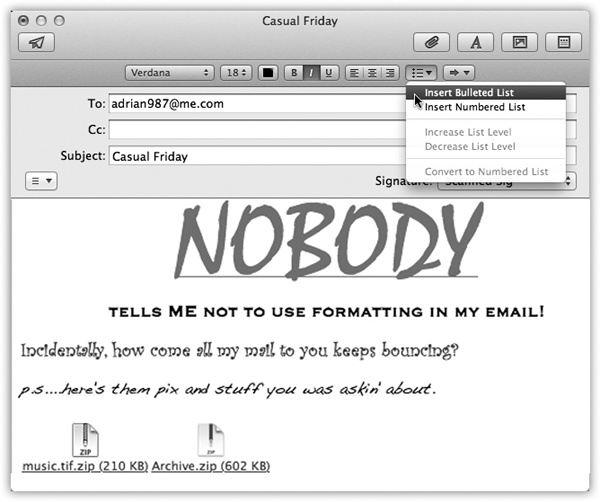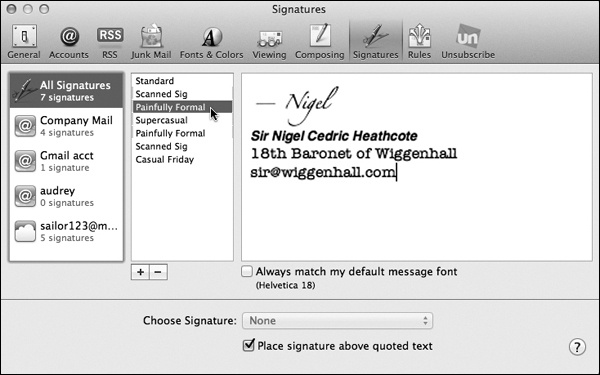To send an email, click ![]() in the toolbar or press
in the toolbar or press ![]() -N. The New Message form, shown in Figure 11-4, opens. Here’s
how you go about writing a message:
-N. The New Message form, shown in Figure 11-4, opens. Here’s
how you go about writing a message:
In the “To:” field, type the recipient’s email address.
If somebody is in your Address Book, type the first couple of letters of the name or email address; Mail automatically completes the address. (If the first guess is wrong, type another letter or two until Mail revises its guess.)
Figure 11-4. If you want to use formatting, click the Show Format Bar icon (
 ) on the toolbar to open the Format bar—a
strip of buttons for font, style, color, justification, bulleted
lists, indentation, and so on. (The Format menu contains menu
versions of the same stuff.)
) on the toolbar to open the Format bar—a
strip of buttons for font, style, color, justification, bulleted
lists, indentation, and so on. (The Format menu contains menu
versions of the same stuff.)Tip
If Mail constantly tries to autofill in the address of someone you don’t really communicate with, you can zap that address from its memory by choosing Window→Previous Recipients. Click the undesired address, and then click Remove From List.
As in most dialog boxes, you can jump from blank to blank (from “To:” to “Cc:,” for example) by pressing Tab. To send this message to more than one person, separate the addresses with commas: [email protected], [email protected], and so on.
Tip
If you send most of your email to addresses within the same organization (like [email protected], [email protected], and [email protected]), Mail can automatically turn all other email addresses red. It’s a feature designed to avoid sending confidential messages to outside addresses.
To turn this feature on, choose Mail→Preferences, click Composing, turn on “Mark addresses not ending with,” and then type the “safe” domain (like apple.com) into the blank.
To send a copy to other recipients, enter their addresses in the “Cc:” field.
Cc stands for carbon copy. Getting an email message where your name is in the “Cc:” line implies: “I sent you a copy because I thought you’d want to know about this correspondence, but I’m not expecting you to reply.”
Tip
If Mail recognizes the address you type into the “To:” or “Cc:” box (because it’s someone in your Address Book, for instance), then the name turns into a shaded, round-ended box button. In addition to looking cool, these buttons sprout a ▾ when you point to them; when you click there, you get a list of useful commands (including Show Contact Card).
These buttons are also drag-and-droppable. For example, you can drag one from the “To:” field to the “Cc:” field, or from Address Book to Mail.
Type the topic of the message in the Subject field.
It’s courteous to put some thought into the subject line. (Use “Change in plans for next week,” for instance, instead of “Yo.”) On the other hand, don’t put the entire message into the subject line, either.
Specify an email format.
There are two kinds of email: plain text and formatted (which Apple calls Rich Text—not to be confused with Rich Text Format word processing format, which is very different). Plain text messages are faster to send and open, are universally compatible with the world’s email programs, and are greatly preferred by many veteran computer fans. And even though the message itself is plain, you can still attach pictures and other files.
By contrast, formatted messages sometimes appear without any formatting at all in some email programs.
To control which kind of mail you send on a message-by-message basis, choose from the Format menu either Make Plain Text or Make Rich Text. To change the factory setting for new outgoing messages, choose Mail→Preferences; click the Composing icon; and choose from the Message Format pop-up menu.
Type your message in the message box.
You can use all standard editing techniques, including copy and paste, drag and drop, and so on. If you selected the Rich Text style of email, you can use word processor–like formatting (Figure 11-4).
As you type, Mail checks your spelling, using a dotted underline to mark questionable words. You can read much more about Mac OS X’s built-in spelling/grammar checker (and typing expander) in Chapter 5.
If you’re composing a long email message, or if it’s one you don’t want to send until later, click the Save as Draft button, press
 -S, or choose File→Save. You’ve just saved
the message in your Drafts folder. It’ll still be there the next
time you open Mail. To reopen a saved draft later, click the
Drafts icon in the mailboxes column and then double-click the
message you want to work on.
-S, or choose File→Save. You’ve just saved
the message in your Drafts folder. It’ll still be there the next
time you open Mail. To reopen a saved draft later, click the
Drafts icon in the mailboxes column and then double-click the
message you want to work on.Click Send
 (or press Shift-
(or press Shift- -D).
-D).Mail sends the message.
Tip
To resend a message you’ve already sent, click it and then
choose Message→Send Again, or press Shift-![]() -D.
-D.
If you’d rather have Mail place each message you write in the Outbox folder instead of connecting to the Internet when you click Send, choose Mailbox→Take All Accounts Offline. While you’re offline, Mail refrains from trying to connect, which is a great feature when you’re working on a laptop at 39,000 feet and didn’t feel like paying for WiFi. (Choose Mailbox→Take All Accounts Online to reverse the procedure.)
Sending little text messages is fine, but it’s not much help when you want to send somebody a photograph, a sound, or a Word document. To attach a file to a message you’ve written, use one of these methods:
Drag the icons you want to attach directly off the desktop (or out of a folder) and into the New Message window. There your attachments appear with their own hyperlinked icons (visible in Figure 11-4), meaning that your recipient can simply click to open them.
Tip
Exposé was born for this moment. Hit
 -F3 to make all open windows flee to the
edges of the screen, revealing the desktop. Root around until
you find the file you want to send. Begin dragging it; without
releasing the mouse, press
-F3 to make all open windows flee to the
edges of the screen, revealing the desktop. Root around until
you find the file you want to send. Begin dragging it; without
releasing the mouse, press  -F3 again to bring your message window
back into view. Complete your drag into the message
window.
-F3 again to bring your message window
back into view. Complete your drag into the message
window.Mail makes it look as though you can park the attached file’s icon (or the full image of a graphics file) inside the text of the message, mingled with your typing. Don’t be fooled, however; on the receiving end, all the attachments will be clumped together at the end of the message (unless your recipient also uses Mail or you’ve sent pictures with Stationery).
Drag the icons you want to attach from the desktop onto Mail’s Dock icon. Mail dutifully creates a new outgoing message, with the files already attached.
Click the (
 ) on the New Message toolbar, choose
File→Attach Files, or press Shift-
) on the New Message toolbar, choose
File→Attach Files, or press Shift- -A. The standard Open File sheet now
appears so you can navigate to and select the files you want to
include. (You can choose multiple files simultaneously in this
dialog box. Just
-A. The standard Open File sheet now
appears so you can navigate to and select the files you want to
include. (You can choose multiple files simultaneously in this
dialog box. Just  -click or Shift-click the individual files
you want as though you were selecting them in a Finder
window.)
-click or Shift-click the individual files
you want as though you were selecting them in a Finder
window.)Once you’ve selected them, click Choose File (or press Return). You return to the New Message window, where the attachments’ icons appear, ready to ride along when you send the message.
To remove an attachment, drag across its icon to highlight it, and then press the Delete key. (You can also choose Message→Remove Attachments.)
Signatures are bits of text that get stamped at the bottom of your outgoing email messages. A signature might contain a name, a postal address, a pithy quote, or even a scan of your real signature.
You can customize your signatures, as shown in Figure 11-5, by choosing Mail→Preferences→Signatures. Here’s what you should know:
To build up a library of signatures that you can use in any of your accounts: Select All Signatures in the leftmost pane, and then click the + button to add each new signature (Figure 11-5). Give each new signature a name in the middle pane, and then customize the signatures’ text in the rightmost pane.
To make a signature available in one of your email accounts: Drag the signature’s name from the middle pane onto the name of the account in the leftmost pane. In other words, you can make certain signatures available to only your work (or personal) account, so you never accidentally end up appending your secret FBI contact signature to the bottom of a birthday invitation you send out.
Figure 11-5. After naming your signature in the middle pane and typing the text on the right, don’t miss the Format menu, which you can use to dress up your signature with colors and formatting. You can even paste a picture into the signature box. Click OK when you’re finished. (You can use formatted signatures only when sending Rich Text messages.)
To assign a particular signature to one account: In the left pane, click an account; pick from the Choose Signature pop-up menu. Each time you compose a message from that account, Mail inserts the signature you selected.
Remember that you can always change your signature on a message-by-message basis, using the Signature pop-up menu in any new email message.
To use the signature feature as a prefix in replies: Turn on “Place signature above quoted text.” If you turn on this setting, your signature gets inserted above any text that you’re replying to, rather than below. You’d use this setting if your “signature” said something like, “Hi there! You wrote this to me!”


